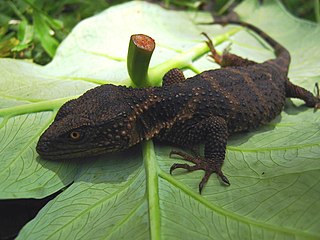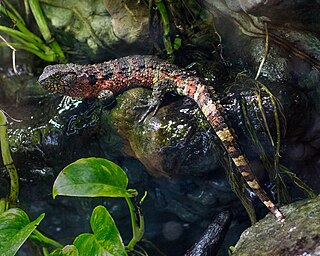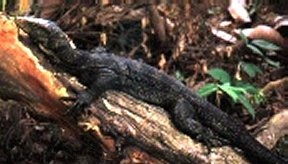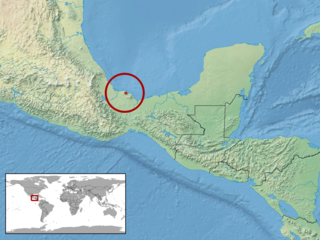
Xenosauridae is a family of anguimorph lizards whose only living representative is the genus Xenosaurus, which is native to Central America. Xenosauridae also includes the extinct genera Exostinus and Restes. Also known as knob-scaled lizards, they have rounded, bumpy scales and osteoderms. Most living species prefer humid, rocky habitats, although they are widespread within their native regions, with some inhabiting semi-arid scrub environments. They are carnivorous or insectivorous, and give birth to live young.

The Mexican blind lizard is a species of legless lizard in the family Dibamidae, and the only species in the genus Anelytropsis. It is endemic to Mexico. They look like Amphisbaenia, but are in fact, only distantly related.

Lacerta is a genus of lizards of the family Lacertidae.

Xenosaurus is a genus of lizards. Xenosaurus is the only extant genus in the family Xenosauridae with 12 species currently recognized. Also known as the Middle American knob-scaled lizards found in southwestern Tamaulipas and eastern Guerrero on the Atlantic and Pacific versants of Mexico, respectively, south and east to Alta Verapaz, Guatemala. They can bfound between 300 m and 2360 m of elevation in a wide variety of habitats ranging from xerophytic tropical scrub to cloud forest to tropical rain forest. Where they occupy moderately diverse places, including crevices and holes in limestone, spaces under volcanic boulders, crevices in volcanic rocks, karst limestone, limestone terrain, and hollow logs in dry areas where trees are sparse. A flattened body shape and a crevice-dwelling ecology generally characterize species in the group. In part because of their habitat specialization, all of the known species and subspecies are allopatric, and several have small geographic distributions.Dorsal scales are heteromorphic, not imbrication, and some are conical or developed into enlarged tubercles separated by small granular scales. Ventral scales are flat, quadrate, and arranged in transverse rows. Head scales are generally small, tuberculate, and sometimes conical or rugose, but may be enlarged along the rostra and temporal ridges. Supraoculars also are enlarged, flattened, and in a single longitudinal row. The skin of the neck is loose and expanded, producing at least two angular fold. These lizards are known to feed on a variety of crawling and flying insects. This genus mostly eats orthopterans, coleopterans (beetles), dipterans, and myriapods.

The slender glass lizard is a legless lizard in the family Anguidae. The species is endemic to the United States. Two subspecies are recognized. The lizard was originally believed to be a subspecies of the eastern glass lizard. Their name comes from their easily broken tail which they can break off themselves without ever being touched. It is difficult to find a specimen with an undamaged tail. The lizard eats a variety of insects and small animals, including smaller lizards. Snakes and other animals are known to prey on the species. Humans have a part in destroying their environment and killing their food supply with insecticides. The lizard is considered to be a least-concern species according to the International Union for Conservation of Nature (IUCN), though it is vulnerable in Iowa and endangered in Wisconsin.

Xenosaurus grandis, commonly known as the knob-scaled lizard, is a species of diurnal, terrestrial lizard endemic to Mexico and Guatemala. It primarily inhabits tropical rainforests. It dwells in rock crevices and eats insects.

The Chinese crocodile lizard is a semiaquatic lizard found only in cool forests in the Hunan, Guangxi and Guizhou Provinces of southern China, and the Quảng Ninh Province in northern Vietnam. The Chinese crocodile lizard spends much of its time in shallow water or in overhanging branches and vegetation, where it hunts its prey of insects, snails, tadpoles, and worms. Individuals in captivity may be fed baby mice. A rare and little-studied lizard, it is listed in CITES Appendix II, which regulates international trade of specimens. This is the only species in the monotypic genus Shinisaurus.

Ctenosaura pectinata, commonly known as the Mexican spiny-tailed iguana or the Mexican spinytail iguana, is a moderate-sized lizard endemic to western Mexico.
The sandstone night lizard is a species of night lizard. Prior to 2005, it was considered a subspecies of the granite night lizard, Xantusia henshawi. The physical difference is that the sandstone night lizard has lighter coloration.

The western blue-tongued lizard, also known as the western blue-tongued skink, is a large skink native to Australia. It is one of six species of blue-tongued skinks found in Australia, though further species are found in New Guinea and Indonesia.

The Gray's monitor is a large monitor lizard known only from lowland dipterocarp forest in southern Luzon, Catanduanes, and Polillo Island, all islands in the Philippines. It is also known as Gray's monitor lizard, butaan, and ornate monitor. It belongs to the subgenus Philippinosaurus. It is largely arboreal and extremely shy. The Northern Sierra Madre monitor lizard was thought to be of same species with Gray's monitor until a research concluded in 2010 that northern populations of Gray's monitor was a distinct species, now known as V. bitatawa.
The orange-throated flat lizard is a species of lizard in the Cordylidae family.

The Transvaal grass lizard, also known as the Coppery grass lizard and Transvaal snake lizard is a species of lizard in the genus Chamaesaura. It is found in southern African grasslands and on slopes. The Transvaal grass lizard is ovoviparous. The scientific name refers to its copper colour.

Abronia reidi is a species of arboreal alligator lizard in the family Anguidae. The species is native to Mexico. It was described as a species new to science in 1961 by John E. Werler and Frederick A. Shannon.

Xenosaurus platyceps, the flathead knob-scaled lizard, is a lizard found in the Sierra Madre Oriental of Mexico. Its natural habitat is dry scrub forest and oak savanna. The species is endangered due to habitat fragmentation for the development of tourism and agriculture as well as predation by feral cats. Currently, the flathead knob-scaled lizard does not live in a protected area.

Shinisauria is a clade or evolutionary grouping of anguimorph lizards that includes the living Chinese crocodile lizard Shinisaurus and several of its closest extinct relatives. Shinisauria was named in 2008 as a stem-based taxon to include all anguimorphs more closely related to Shinisaurus than to any other lizard. Several recent phylogenetic analyses of lizard evolutionary relationships place Shinisauria in a basal position within the clade Platynota, which also includes monitor lizards, helodermatids, and the extinct mosasaurs. Shinisaurians were once thought to be closely related to the genus Xenosaurus, but they are now considered distant relatives within Anguimorpha. The fossil record of shinisaurians extends back to the Early Cretaceous with Dalinghosaurus, which is from the Yixian Formation of China. Two other extinct shinisaurians are currently known: Bahndwivici from the Eocene of Wyoming and Merkurosaurus from the Early Miocene of the Czech Republic.

Neoanguimorpha is a clade of anguimorphs comprising Monstersauria and Diploglossa. Morphological studies in the past had classified helodermatids with the varanoids in the clade Platynota, while the Chinese crocodile lizard was classified as a xenosaurid. However molecular work found no support in these groupings and instead has found the helodermatids more related to Diploglossa, while the Chinese crocodile lizard and varanoids to form the clade Paleoanguimorpha.

Paleoanguimorpha is a clade of anguimorphs comprising Shinisauria and Goannasauria. Morphological studies in the past also classified helodermatids and pythonomorphs with the varanoids in the clade Platynota, while the Chinese crocodile lizard was classified as a xenosaurid. Current molecular work finds no support in these groupings and instead has found the helodermatids more related to Diploglossa in the sister clade Neoanguimorpha, while the Chinese crocodile lizard is the closet living relative to varanoids. Pythonomorphs represented by snakes today are not closely related to varanoids and are instead a sister lineage to Anguimorpha and Iguania in the clade Toxicofera.

Diploglossa is a clade of neoanguimorphs represented by the families Xenosauridae, Diploglossidae, Anniellidae and Anguidae, the latter three placed in the superfamily Anguioidea. In the past the Chinese crocodile lizard was classified as a xenosaurid; current molecular work has shown evidence the species related to varanoids in the clade Paleoanguimorpha.















